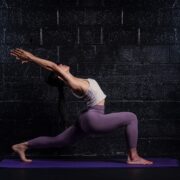
Enhance Your Range of Motion with Flexibility Training
Flexibility training is a crucial component of overall fitness that focuses on improving the range of motion in your joints and muscles. It involves various stretching exercises and techniques that help to increase flexibility and mobility. Flexibility is important because it allows you to move freely and easily, which can enhance your performance in physical activities and reduce the risk of injury.
Key Takeaways
- Flexibility training can improve range of motion, reduce risk of injury, and enhance athletic performance.
- Range of motion refers to the degree of movement in a joint or group of joints.
- Types of flexibility training include static stretching, dynamic stretching, and PNF stretching.
- Static stretching involves holding a stretch for a period of time, while dynamic stretching involves moving through a range of motion.
- Yoga and Pilates are popular forms of flexibility training that also offer additional benefits such as stress reduction and improved balance.
Benefits of Flexibility Training
1. Improved Range of Motion: One of the main benefits of flexibility training is an improved range of motion. When your muscles and joints are flexible, you are able to move them through their full range of motion without any restrictions. This can be particularly beneficial for athletes who need to perform movements that require a wide range of motion, such as gymnasts or dancers.
2. Reduced Risk of Injury: Flexibility training can help to reduce the risk of injury by improving the flexibility and elasticity of your muscles and tendons. When your muscles are more flexible, they are less likely to become strained or torn during physical activity. Additionally, increased flexibility can help to improve your posture and alignment, which can also reduce the risk of injury.
3. Enhanced Athletic Performance: Flexibility training can also enhance athletic performance by improving your overall mobility and flexibility. When your muscles are more flexible, they are able to generate more power and force, which can improve your performance in activities such as running, jumping, or lifting weights. Additionally, increased flexibility can help to improve your balance and coordination, which are important for many sports and physical activities.
4. Reduced Muscle Soreness: Another benefit of flexibility training is reduced muscle soreness. When you stretch your muscles after a workout, it helps to flush out lactic acid and other waste products that can build up in your muscles during exercise. This can help to reduce muscle soreness and stiffness, allowing you to recover more quickly from intense workouts.
Understanding Range of Motion
Range of motion refers to the amount of movement that is possible in a joint or group of joints. It is influenced by various factors, including the structure of your joints, the length and elasticity of your muscles and tendons, and your overall flexibility. Maintaining a healthy range of motion is important because it allows you to perform everyday activities with ease and can prevent the development of muscle imbalances or joint dysfunctions.
Factors that affect range of motion include age, gender, genetics, and physical activity level. As we age, our joints tend to become stiffer and less flexible, which can lead to a decrease in range of motion. Women also tend to have greater flexibility than men due to differences in muscle and tendon elasticity. Additionally, genetics can play a role in determining your natural flexibility level.
Maintaining a healthy range of motion is important for several reasons. It can help to prevent muscle imbalances and joint dysfunctions, which can lead to pain and injury. It can also improve your posture and alignment, which can reduce the risk of developing chronic conditions such as back pain or arthritis. Finally, maintaining a healthy range of motion can enhance your overall quality of life by allowing you to move freely and easily.
Types of Flexibility Training
| Type of Flexibility Training | Description | Benefits |
|---|---|---|
| Static Stretching | Stretching a muscle to its farthest point and holding it for a period of time | Improves flexibility, reduces muscle tension, and increases range of motion |
| Dynamic Stretching | Moving a muscle through its full range of motion in a controlled manner | Improves flexibility, increases blood flow to muscles, and prepares the body for physical activity |
| Ballistic Stretching | Bouncing or jerking movements to stretch a muscle beyond its normal range of motion | Can cause injury and is not recommended as a form of flexibility training |
| PNF Stretching | A technique that involves contracting and relaxing a muscle while stretching it | Improves flexibility, increases range of motion, and can help with muscle imbalances |
There are several different types of flexibility training that can be used to improve flexibility and range of motion. These include static stretching, dynamic stretching, proprioceptive neuromuscular facilitation (PNF) stretching, and practices such as yoga and Pilates.
1. Static Stretching: Static stretching is the most common type of flexibility training and involves holding a stretch for a prolonged period of time (usually 30 seconds to 1 minute). This type of stretching helps to lengthen and relax the muscles, allowing them to become more flexible over time.
2. Dynamic Stretching: Dynamic stretching involves moving your muscles and joints through a full range of motion in a controlled and fluid manner. This type of stretching is often used as part of a warm-up routine before physical activity, as it helps to increase blood flow to the muscles and prepare them for movement.
3. Proprioceptive Neuromuscular Facilitation (PNF) Stretching: PNF stretching is a more advanced form of flexibility training that involves a combination of static stretching and muscle contraction. It is often done with a partner or using a resistance band, and can help to improve flexibility and range of motion more quickly than other types of stretching.
4. Yoga and Pilates: Yoga and Pilates are practices that focus on improving flexibility, strength, and balance through a series of controlled movements and stretches. These practices often incorporate elements of both static and dynamic stretching, as well as strengthening exercises for the core muscles.
Static Stretching Techniques
Static stretching involves holding a stretch for a prolonged period of time to lengthen and relax the muscles. Here are some examples of static stretching exercises:
1. Hamstring Stretch: Sit on the floor with one leg extended in front of you and the other leg bent with the foot resting against the inner thigh. Reach forward with both hands and try to touch your toes, keeping your back straight. Hold the stretch for 30 seconds to 1 minute, then switch legs.
2. Quadriceps Stretch: Stand tall with your feet hip-width apart. Bend one knee and bring your heel towards your glutes, grabbing onto your ankle or foot with your hand. Gently pull your heel towards your glutes until you feel a stretch in the front of your thigh. Hold for 30 seconds to 1 minute, then switch legs.
3. Chest Stretch: Stand tall with your feet hip-width apart. Interlace your fingers behind your back and straighten your arms, squeezing your shoulder blades together. Lift your arms away from your body until you feel a stretch in your chest and shoulders. Hold for 30 seconds to 1 minute.
Tips for safe and effective static stretching:
– Warm up your muscles before static stretching by doing some light cardio exercises, such as jogging or jumping jacks.
– Breathe deeply and relax into each stretch, avoiding any bouncing or jerking movements.
– Start with easier stretches and gradually increase the intensity and duration of your stretches over time.
– Stretch both sides of your body equally to maintain balance and symmetry.
Dynamic Stretching Techniques
Dynamic stretching involves moving your muscles and joints through a full range of motion in a controlled and fluid manner. Here are some examples of dynamic stretching exercises:
1. Arm Circles: Stand tall with your feet hip-width apart. Extend your arms out to the sides at shoulder height. Begin making small circles with your arms, gradually increasing the size of the circles. After a few seconds, reverse the direction of the circles. Continue for 30 seconds to 1 minute.
2. Walking Lunges: Stand tall with your feet hip-width apart. Take a step forward with your right foot and lower your body into a lunge position, keeping your front knee directly above your ankle. Push off with your right foot and bring your left foot forward into the next lunge. Continue walking forward, alternating legs, for 10-12 lunges.
3. Leg Swings: Stand tall next to a wall or support for balance. Swing one leg forward and backward in a controlled manner, keeping it straight and engaging your core muscles. After a few swings, switch legs and swing the other leg forward and backward. Continue for 30 seconds to 1 minute.
Tips for safe and effective dynamic stretching:
– Start with smaller movements and gradually increase the range of motion as you warm up.
– Move in a controlled manner, avoiding any jerking or bouncing movements.
– Focus on engaging the muscles being stretched and maintaining good posture throughout the movements.
– Choose dynamic stretches that mimic the movements you will be performing during your workout or activity.
Proprioceptive Neuromuscular Facilitation (PNF) Stretching
Proprioceptive Neuromuscular Facilitation (PNF) stretching is a more advanced form of flexibility training that involves a combination of static stretching and muscle contraction. It is often done with a partner or using a resistance band. Here are some examples of PNF stretching exercises:
1. Hamstring PNF Stretch: Lie on your back with one leg extended straight up towards the ceiling. Loop a resistance band around the ball of your foot and hold onto the ends of the band with both hands. Gently pull on the band to stretch your hamstring, then contract your hamstring by pushing against the band for 5-10 seconds. Relax and repeat the stretch 2-3 times, then switch legs.
2. Shoulder PNF Stretch: Stand tall with your feet hip-width apart and hold a resistance band in front of you with both hands, palms facing down. Raise your arms overhead and behind you, stretching your shoulders and chest. Hold the stretch for a few seconds, then contract your shoulder muscles by pulling against the resistance band for 5-10 seconds. Relax and repeat the stretch 2-3 times.
3. Hip PNF Stretch: Sit on the floor with one leg extended straight in front of you and the other leg bent with the foot resting against the inner thigh. Place your hands on either side of your extended leg and lean forward, stretching your hip and hamstring. Hold the stretch for a few seconds, then contract your hip muscles by pushing against your hands for 5-10 seconds. Relax and repeat the stretch 2-3 times, then switch legs.
Tips for safe and effective PNF stretching:
– Start with lighter resistance or shorter holds and gradually increase the intensity and duration of the stretches over time.
– Communicate with your partner or listen to your body’s feedback to ensure that you are not pushing too hard or causing any pain or discomfort.
– Focus on relaxing and breathing deeply during the stretches to allow your muscles to lengthen and relax.
– Always warm up your muscles before attempting PNF stretching to reduce the risk of injury.
Yoga and Pilates for Flexibility
Yoga and Pilates are practices that focus on improving flexibility, strength, and balance through a series of controlled movements and stretches. Both practices can be beneficial for improving overall flexibility and range of motion. Here is an overview of yoga and Pilates, as well as some examples of exercises for flexibility:
1. Yoga: Yoga is an ancient practice that combines physical postures, breathing exercises, and meditation to promote physical and mental well-being. There are many different styles of yoga, ranging from gentle and restorative to more vigorous and challenging. Some examples of yoga poses that can improve flexibility include:
– Downward Dog: Start on your hands and knees, then lift your hips up towards the ceiling, forming an upside-down V shape with your body. Press your heels towards the floor and lengthen your spine. Hold for 30 seconds to 1 minute.
– Triangle Pose: Stand tall with your feet wide apart. Turn your right foot out 90 degrees and extend your arms out to the sides at shoulder height. Hinge at the hips and reach your right hand towards your right foot, keeping your left arm extended towards the ceiling. Hold for 30 seconds to 1 minute, then switch sides.
– Pigeon Pose: Start in a high plank position, then bring your right knee towards your right wrist, placing your right foot near your left hip. Extend your left leg behind you, keeping your hips square. Lower down onto your forearms or a block if needed. Hold for 30 seconds to 1 minute, then switch sides.
2. Pilates: Pilates is a low-impact exercise method that focuses on strengthening the core muscles, improving posture, and increasing flexibility and mobility. It involves a series of controlled movements that target the deep muscles of the abdomen, back, and hips. Some examples of Pilates exercises that can improve flexibility include:
– Roll Up: Lie on your back with your legs extended and your arms reaching overhead. Inhale as you roll your head, neck, and shoulders off the mat, reaching towards your toes. Exhale as you slowly roll back down to the starting position. Repeat for 8-10 repetitions.
– Spine Twist: Sit tall with your legs extended in front of you and your arms reaching out to the sides at shoulder height. Inhale as you twist your torso to the right, reaching your left hand towards your right foot and your right hand behind you. Exhale as you return to the starting position, then repeat on the other side. Repeat for 8-10 repetitions.
– Swan Dive: Lie on your stomach with your legs extended and your arms reaching overhead. Inhale as you lift your head, chest, and arms off the mat, reaching towards your toes. Exhale as you lower back down to the starting position. Repeat for 8-10 repetitions.
Pre-Workout and Post-Workout Stretching
Stretching before and after exercise is important for several reasons. Before a workout, stretching can help to warm up your muscles and prepare them for movement. It can also help to increase blood flow to the muscles, which can improve performance and reduce the risk of injury. After a workout, stretching can help to cool down your muscles and prevent them from becoming tight or stiff.
When stretching before a workout, it is important to focus on dynamic stretching exercises that mimic the movements you will be performing during your workout. This can help to activate the muscles and increase blood flow to the working muscles. Some examples of dynamic stretching exercises for a pre-workout warm-up include leg swings, arm circles, and walking lunges.
When stretching after a workout, it is important to focus on static stretching exercises that target the muscles you have just worked. This can help to lengthen and relax the muscles, reducing the risk of muscle soreness and stiffness. Some examples of static stretching exercises for a post-workout cool-down include hamstring stretches, quadriceps stretches, and chest stretches.
Tips for safe and effective pre-workout and post-workout stretching:
– Always warm up your muscles with some light cardio exercises before stretching.
– Focus on dynamic stretching before a workout and static stretching after a workout.
– Breathe deeply and relax into each stretch, avoiding any bouncing or jerking movements.
– Stretch both sides of your body equally to maintain balance and symmetry.
– Listen to your body’s feedback and avoid any stretches that cause pain or discomfort.
Incorporating Flexibility Training into Your Fitness Routine
Incorporating flexibility training into your fitness routine is important for maintaining overall flexibility and range of motion. Here are some tips for incorporating flexibility training into your fitness routine:
1. Schedule dedicated flexibility sessions: Set aside specific times during the week to focus solely on flexibility training. This can be done in addition to your regular workouts or on rest days. Aim for at least 2-3 flexibility sessions per week to see noticeable improvements in your flexibility. During these sessions, incorporate a variety of stretching exercises that target different muscle groups. This can include static stretches, dynamic stretches, and proprioceptive neuromuscular facilitation (PNF) techniques. Remember to warm up before each session to prevent injury and gradually increase the intensity and duration of your stretches over time. Consistency is key, so make sure to stick to your schedule and track your progress to stay motivated.
FAQs
What is flexibility training?
Flexibility training is a type of exercise that focuses on improving the range of motion of your joints and muscles. It involves stretching and other exercises that help to increase your flexibility and mobility.
What are the benefits of flexibility training?
Flexibility training can help to improve your range of motion, reduce the risk of injury, improve your posture, and enhance your athletic performance. It can also help to reduce muscle soreness and stiffness, and improve your overall quality of life.
What are some examples of flexibility exercises?
Some examples of flexibility exercises include static stretching, dynamic stretching, yoga, Pilates, and foam rolling. These exercises can help to improve your flexibility and mobility, and can be done at home or in a gym.
How often should I do flexibility training?
It is recommended that you do flexibility training at least two to three times per week. However, you can do it more often if you feel like you need to improve your flexibility or mobility.
Is flexibility training safe?
Flexibility training is generally safe for most people. However, it is important to warm up properly before doing any stretching or other exercises, and to avoid overstretching or pushing yourself too hard. If you have any medical conditions or injuries, it is important to consult with your doctor before starting any new exercise program.


















